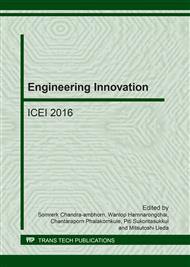p.36
p.42
p.48
p.54
p.60
p.66
p.72
p.78
p.85
Overlay Welding on Titanium and 304 Stainless Steel Using ERNiCu-7 Filler Metal by GTAW Process
Abstract:
Single pass overlay welding of the ERNiCu-7 filler metal on the commercial pure titanium grade 2 and the 304 stainless steel using the gas tungsten arc welding (GTAW) process was studied. The ERNiCu-7 filler metal was overlay welded on the base metals with varying welding currents; it was 30A, 40A and 50A for the CP-Ti base metal and 50A, 60A and 70A for the 304SS base metal. The experimental results showed that the overlay CP-Ti welded-specimen, increasing of welding current increased bead width and decreased depth of penetration of weldment. While for the 304SS welded-specimen, increasing of welding current increased both bead width and depth of penetration. Suitable heat inputs to achieve good geometry of weldment for overlay welding were 348J/mm for CP-Ti welded-specimen and 558J/mm for 304SS welded-specimen.
Info:
Periodical:
Pages:
60-65
Citation:
Online since:
January 2017
Keywords:
Price:
Сopyright:
© 2017 Trans Tech Publications Ltd. All Rights Reserved
Share:
Citation:


